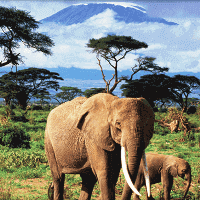Plan your Kenyan Tour and Trip Comfortably - Best Advice

Preparing for a safari trip to Kenya means weighing a lot of factors that might take a lot of your time. Why not talk to a resourceful local consultant like Homejoy Safari Adventures & get set up smoothly for your Kenya Safari tour?



Ensure to Make new discoveries and learn new things
What Are the Best Safari Parks to Visit in Kenya for Wildlife Lovers
, Narok County
Kenya
Kenya is home to some of the most spectacular safari parks, making it a prime destination for wildlife lovers seeking an authentic African adventure. The country boasts an incredible variety of landscapes, from vast golden savannahs to lush wetlands, thick forests, and towering mountains, each supporting a diverse range of wildlife. These national parks and reserves serve as safe havens for some of the world’s most iconic species, including the legendary Big Five, lions, elephants, leopards, rhinos, and buffaloes, along with cheetahs, giraffes, hippos, and countless bird species. This biodiversity makes Kenya one of the most sought-after safari destinations in the world. Each of Kenya’s safari parks offers a unique experience, drawing wildlife enthusiasts, photographers, conservationists, and adventure travelers alike. Some parks, such as the famous Masai Mara, are known for their high predator density and the world-renowned Great Migration, where millions of wildebeests, zebras, and gazelles journey across vast plains in search of fresh pastures. Others, like Amboseli National Park, provide up-close encounters with massive elephant herds against the backdrop of Mount Kilimanjaro. Lake Nakuru National Park is a paradise for birdwatchers, boasting vast flocks of flamingos and a thriving rhino sanctuary. Tsavo, the largest national park in Kenya, is known for its rugged wilderness, red-dusted elephants, and dramatic landscapes. Tourists from across the globe, particularly from the United States, the United Kingdom, Germany, France, and China, travel to Kenya to witness the raw beauty and untamed wildlife that these safari parks offer. Whether it’s the thrill of seeing a lioness on the hunt, the breathtaking spectacle of wildebeests braving crocodile-infested rivers, or the peaceful sight of giraffes silhouetted against the sunset, each moment on safari is unforgettable. The country’s commitment to wildlife conservation and eco-tourism ensures that these magnificent landscapes and species continue to thrive for generations to come. In addition to classic game drives, visitors can experience Kenya’s wildlife in unique and immersive ways, from guided walking safaris with indigenous Maasai warriors to exhilarating hot air balloon rides over the vast plains at sunrise. Night game drives reveal the elusive nocturnal creatures that remain hidden during the day, while boat safaris on freshwater lakes provide an alternative way to observe hippos, crocodiles, and aquatic bird species up close. Kenya’s national parks cater to every traveler’s preferences, with accommodation options ranging from luxurious five-star lodges to eco-friendly tented camps and budget-friendly bush stays. Kenya’s safaris offer not just thrilling wildlife encounters but also a deep cultural experience. Many reserves border Maasai and Samburu villages, allowing visitors to interact with indigenous communities and learn about their traditions, warrior culture, and centuries-old coexistence with wildlife. These encounters add another layer of enrichment to a Kenyan safari, making it more than just a wildlife adventure, it becomes a journey into the soul of Africa. Whether you’re a first-time safari-goer or a seasoned traveler, Kenya’s national parks promise an unparalleled connection with nature, adventure, and the extraordinary wildlife that calls this land home.
Encounter Masai Mara National Reserve: The Crown Jewel of Kenya’s Safaris
 Masai Mara is the ultimate safari destination for wildlife enthusiasts. This world-renowned reserve is famous for its vast open plains teeming with diverse wildlife, including the Big Five: lions, elephants, buffaloes, leopards, and rhinos. The Masai Mara is also home to one of the most spectacular natural events on Earth, the Great Migration. Every year, millions of wildebeests, zebras, and gazelles make their way from Tanzania’s Serengeti into Kenya’s Masai Mara, braving crocodile-infested rivers and hungry predators in one of nature’s greatest survival spectacles. Apart from witnessing the migration, visitors can enjoy unrivaled game-viewing experiences throughout the year. The Mara’s high concentration of predators ensures that there is always action to witness, whether it’s a pride of lions hunting, cheetahs sprinting across the plains, or scavengers competing for a share of the spoils. The breathtaking landscapes, adorned with acacia trees and rolling grasslands, create a picturesque setting for wildlife photography and immersive safari experiences.The best time to visit the Masai Mara is from July to October, during the Great Migration. This period offers the most dramatic wildlife spectacles, as over two million wildebeests, zebras, and gazelles cross the Mara River, facing off against hungry crocodiles and other predators. The dry season provides excellent visibility, making it easier to spot wildlife concentrated around water sources. However, Masai Mara remains a year-round safari destination with consistent game viewing. The rainy seasons, from November to May, bring lush green landscapes, newborn wildlife, and fewer tourists, providing a quieter and more intimate safari experience. Masai Mara offers a range of extraordinary experiences beyond traditional game drives. Hot air balloon safaris at sunrise provide breathtaking aerial views of the vast savannah and the migrating herds below, followed by a champagne breakfast in the wild. Guided walking tours led by Maasai warriors allow visitors to explore the landscape on foot, learning about the flora, fauna, and survival techniques of the indigenous people. Night game drives provide an opportunity to witness nocturnal predators such as leopards, hyenas, and lions in action. Additionally, cultural visits to Maasai villages offer insight into the traditions, dances, and lifestyle of one of Africa’s most famous indigenous communities, making for an enriching, immersive experience. Masai Mara offers a variety of accommodations catering to different budgets and preferences. Luxury safari lodges, such as Mara Serena Safari Lodge and Angama Mara, provide top-tier service, private game drives, and unparalleled views of the Mara plains. Well-equipped tented camps like Governors’ Camp and Little Governors’ Camp offer a blend of comfort and adventure, with close proximity to wildlife and an authentic bush experience. For budget-conscious travelers, campsites and mid-range lodges provide affordable yet immersive stays. Many accommodations are strategically located near prime wildlife viewing areas, ensuring guests have front-row access to the park’s incredible wildlife throughout their visit.
Masai Mara is the ultimate safari destination for wildlife enthusiasts. This world-renowned reserve is famous for its vast open plains teeming with diverse wildlife, including the Big Five: lions, elephants, buffaloes, leopards, and rhinos. The Masai Mara is also home to one of the most spectacular natural events on Earth, the Great Migration. Every year, millions of wildebeests, zebras, and gazelles make their way from Tanzania’s Serengeti into Kenya’s Masai Mara, braving crocodile-infested rivers and hungry predators in one of nature’s greatest survival spectacles. Apart from witnessing the migration, visitors can enjoy unrivaled game-viewing experiences throughout the year. The Mara’s high concentration of predators ensures that there is always action to witness, whether it’s a pride of lions hunting, cheetahs sprinting across the plains, or scavengers competing for a share of the spoils. The breathtaking landscapes, adorned with acacia trees and rolling grasslands, create a picturesque setting for wildlife photography and immersive safari experiences.The best time to visit the Masai Mara is from July to October, during the Great Migration. This period offers the most dramatic wildlife spectacles, as over two million wildebeests, zebras, and gazelles cross the Mara River, facing off against hungry crocodiles and other predators. The dry season provides excellent visibility, making it easier to spot wildlife concentrated around water sources. However, Masai Mara remains a year-round safari destination with consistent game viewing. The rainy seasons, from November to May, bring lush green landscapes, newborn wildlife, and fewer tourists, providing a quieter and more intimate safari experience. Masai Mara offers a range of extraordinary experiences beyond traditional game drives. Hot air balloon safaris at sunrise provide breathtaking aerial views of the vast savannah and the migrating herds below, followed by a champagne breakfast in the wild. Guided walking tours led by Maasai warriors allow visitors to explore the landscape on foot, learning about the flora, fauna, and survival techniques of the indigenous people. Night game drives provide an opportunity to witness nocturnal predators such as leopards, hyenas, and lions in action. Additionally, cultural visits to Maasai villages offer insight into the traditions, dances, and lifestyle of one of Africa’s most famous indigenous communities, making for an enriching, immersive experience. Masai Mara offers a variety of accommodations catering to different budgets and preferences. Luxury safari lodges, such as Mara Serena Safari Lodge and Angama Mara, provide top-tier service, private game drives, and unparalleled views of the Mara plains. Well-equipped tented camps like Governors’ Camp and Little Governors’ Camp offer a blend of comfort and adventure, with close proximity to wildlife and an authentic bush experience. For budget-conscious travelers, campsites and mid-range lodges provide affordable yet immersive stays. Many accommodations are strategically located near prime wildlife viewing areas, ensuring guests have front-row access to the park’s incredible wildlife throughout their visit.
Explore Amboseli National Park: The Land of Giants
Amboseli National Park is one of Kenya’s most celebrated wildlife destinations, renowned for its breathtaking scenery and abundant elephant population. Situated in the southern part of Kenya near the Tanzanian border, the park offers unparalleled views of Mount Kilimanjaro, Africa’s highest peak. The striking contrast between the towering snow-capped summit and the vast savannah below creates one of the most iconic landscapes in Africa, making Amboseli a top destination for wildlife lovers and photographers alike. What sets Amboseli apart is its high density of elephants, many of which are among the largest in Africa. The park is home to several hundred elephants, including some of the continent’s most well-documented and longest-studied herds. Visitors can witness these magnificent creatures up close as they move across the open plains or gather around the seasonal swamps to drink and bathe. Amboseli is also an excellent location for spotting other wildlife species, including lions, cheetahs, hyenas, giraffes, and an array of birdlife. Beyond its wildlife, Amboseli offers rich cultural experiences, as it is located in the heart of Maasai land. Visitors have the opportunity to interact with the Maasai people, learning about their traditional customs, warrior culture, and deep connection to the land. Guided tours to Maasai villages in Amboseli provide an enriching cultural perspective, complementing the park’s extraordinary natural beauty.
- Best Time to Visit: June to October for clear skies, dry conditions, and excellent wildlife viewing. This period offers the best conditions for wildlife photography, as visibility is at its peak with animals congregating near water sources. The dry season also provides spectacular views of Mount Kilimanjaro, with fewer clouds obstructing the summit.
- Unique Experiences: Amboseli offers unforgettable encounters with free-ranging elephants, which are among the most habituated to human presence, making for close-up photography opportunities. Cultural visits to Maasai villages allow visitors to witness traditional dances, hear folk stories, and gain insight into Maasai traditions. The park is also a paradise for birdwatchers, with over 400 species recorded, including raptors, flamingos, and rare migratory birds that thrive in the park’s wetlands and acacia woodlands. Photographers and nature enthusiasts will appreciate the breathtaking scenery, particularly at sunrise and sunset when the light transforms the park into a golden wonderland.
- Accommodation Options: Amboseli provides a diverse range of accommodation options catering to different budgets. Luxury eco-lodges, such as Tortilis Camp, offer high-end services, exclusive game drives, and sustainable tourism initiatives. Mid-range safari camps provide comfortable stays with excellent views of wildlife-rich areas, while budget-friendly campsites allow adventure seekers to experience the raw beauty of Amboseli without breaking the bank. Many lodges are strategically located near waterholes, providing guests with opportunities to view wildlife from the comfort of their accommodation.
Discover Lake Nakuru National Park: The Birdwatcher’s Paradise
Lake Nakuru National Park is one of Kenya’s most treasured wildlife reserves, famed for its vast flamingo population offering unique flamingo sightings and its role as a sanctuary for endangered rhinos. Located in the heart of the Rift Valley, the park is a haven for birdwatchers, conservation enthusiasts, and photographers seeking breathtaking natural beauty. The shallow, alkaline lake serves as an ideal breeding ground for flamingos, whose pink plumage creates a mesmerizing spectacle as they feed along the shores. In addition to flamingos, Lake Nakuru is home to over 450 bird species, including pelicans, cormorants, and fish eagles, making it a dream destination for bird lovers. Beyond its avian wonders, the park is one of the best places in Kenya to see rhinos in their natural habitat. Lake Nakuru National Park hosts a thriving population of both black and white rhinos, protected within the park’s secure boundaries. Other notable wildlife includes leopards, Rothschild’s giraffes, buffaloes, and troops of baboons, all of which can be spotted within the park’s diverse ecosystems of woodlands, grasslands, and rocky cliffs. Lake Nakuru National Park is a year-round destination, but the best time to visit is between June and February, when water levels are stable, and birdlife is at its peak. During these months, flamingos are present in large numbers, and wildlife is easier to spot as animals congregate near water sources. Visitors to Lake Nakuru can enjoy a variety of activities, including rhino tracking, scenic viewpoints such as Baboon Cliff, and game drives through the acacia forests and open plains. The park’s many hiking trails provide panoramic views of the Rift Valley, while guided birdwatching tours like allow travelers to explore the incredible diversity of avian species up close. Lake Nakuru offers a range of lodging options to suit different budgets. Lakeside lodges, such as Sarova Lion Hill Game Lodge, provide stunning views and luxurious amenities. Safari camps within the park offer comfortable stays close to nature, while budget-friendly guesthouses and eco-lodges provide affordable accommodation for travelers seeking an immersive experience without breaking the bank.
Why is Lake Nakuru famous for flamingos?
Lake Nakuru’s alkaline waters support an abundance of algae, which attracts thousands of flamingos to its shores. These birds, often seen in massive flocks, create an awe-inspiring pink spectacle that has made the park one of Kenya’s most photographed locations. Although flamingo numbers fluctuate due to water levels and food availability, the lake remains one of the best places in Africa to witness this incredible natural display. Homejoy Safari Adventures offers customized safari experiences to these top wildlife parks in Kenya, ensuring travelers get the best out of their safari adventures. Whether you’re looking for a luxury safari or a budget-friendly wildlife tour, Kenya’s national parks offer something for every traveler.
Experience Tsavo National Parks: Kenya’s Largest Wilderness
Tsavo East and Tsavo West National Parks together form the largest protected area in Kenya, covering approximately 22,000 square kilometers. This vast wilderness is a dream destination for adventurous travelers looking for an authentic safari experience away from the crowds. The parks are characterized by dramatic landscapes, including volcanic hills, lava flows, acacia woodlands, and open plains, making them a breathtakingly diverse environment for wildlife viewing. The parks are home to the famous red elephants of Tsavo, whose reddish hue comes from dusting themselves with the region’s iron-rich soil. Tsavo is also known for its fascinating history, including the legendary "man-eating lions of Tsavo," which terrorized railway workers in the late 19th century. Today, the parks are prime locations to observe predators such as lions, leopards, and cheetahs, as well as large populations of herbivores, including buffaloes, giraffes, zebras, and antelopes. Tsavo’s birdlife is equally impressive, with over 500 recorded species, making it a paradise for birdwatchers.
- Best Time to Visit: June to October offers optimal wildlife viewing due to dry conditions that concentrate animals around water sources. The clear skies and moderate temperatures make it an excellent time for game drives and photography.
- Unique Experiences: Tsavo offers visitors a range of unforgettable experiences. Explore the eerie Shetani Lava Flows, a vast field of hardened volcanic rock formed from ancient eruptions. Visit Mzima Springs, a series of crystal-clear natural springs that attract hippos, crocodiles, and numerous bird species. For history lovers, exploring the site of the legendary man-eating lions adds a thrilling historical dimension to the safari experience. Walking safaris and night drives are also available in some areas, providing an alternative and intimate way to experience the wilderness.
- Accommodation Options: Tsavo offers a variety of accommodations catering to different budgets. Luxury lodges, such as Finch Hattons and Kilaguni Serena Safari Lodge, provide stunning views, exclusive game drives, and first-class amenities. Private tented camps offer a balance of comfort and immersion in nature. Budget-friendly campsites allow self-drive safari-goers to experience the wild in an affordable yet adventurous way. Many lodges and camps are strategically located near waterholes, allowing guests to view wildlife right from their accommodations.
Is Tsavo National Park worth visiting?
Absolutely. Tsavo National Park is a must-visit for travelers seeking a remote and unspoiled safari experience. Its vast wilderness, which covers approximately 22,000 square kilometers, provides a unique opportunity to explore Kenya’s largest protected area, where wildlife thrives away from the crowds seen in more popular reserves. The park’s distinct red soil, sprawling savannahs, and volcanic landscapes create a striking environment that sets it apart from other safari destinations. Tsavo is home to diverse wildlife, including large elephant herds, lions, leopards, and the elusive African wild dogs. The park also offers a chance to see rare species such as the gerenuk and the fringe-eared oryx, which are difficult to spot in other regions of Kenya. For birdwatchers, Tsavo boasts over 500 species of birds, making it a paradise for avian enthusiasts. Beyond wildlife viewing, Tsavo provides a range of unique experiences. Visitors can explore the Shetani Lava Flows, an ancient volcanic formation, or visit Mzima Springs, a lush oasis teeming with hippos and crocodiles. The park’s rich history, including the infamous man-eating lions of Tsavo, adds a fascinating cultural element to any safari. For those who crave adventure, Tsavo’s remote location offers a sense of solitude and raw connection to nature, making it a perfect destination for off-the-beaten-path travelers.
Frequently Asked Questions (FAQs) About Kenya's Safari Parks
1. What is the best time of year to go on a safari in Kenya? The best time for a safari in Kenya depends on the wildlife experiences you seek. For the Great Migration, visit between July and October. For birdwatching and lush landscapes, November to April is ideal. The dry season (June to October) is best for general wildlife viewing as animals congregate around water sources.
2. Which safari park in Kenya has the best chances of seeing the Big Five? Masai Mara National Reserve is the best place to see all members of the Big Five, lions, elephants, buffaloes, leopards, and rhinos, due to its high concentration of predators and diverse habitats.
3. How long should I plan for a safari in Kenya? A safari of at least 5 to 7 days is recommended to explore multiple parks and maximize wildlife sightings. Shorter trips (3 to 4 days) can focus on one or two reserves like Masai Mara or Amboseli.
4. Are Kenya’s safari parks safe for tourists? Yes, Kenya’s national parks are generally safe for tourists. It is important to follow the guidance of trained safari guides, stay inside designated areas, and respect wildlife viewing rules to ensure a safe experience.
5. What should I pack for a Kenyan safari? Pack lightweight, breathable clothing in neutral colors, a hat, sunscreen, binoculars, a camera with a zoom lens, insect repellent, and comfortable walking shoes. During cooler months, bring a light jacket for morning and evening game drives.
6. Can I do a self-drive safari in Kenya? Yes, self-drive safaris are possible in parks like Tsavo and Amboseli, but guided safaris are recommended for better wildlife tracking and safety. Self-driving requires a 4x4 vehicle and knowledge of park rules.
7. What type of accommodations are available inside Kenya’s safari parks? Safari parks offer a range of accommodations, including luxury lodges, eco-friendly tented camps, mid-range hotels, and budget campsites. Many lodges are strategically located near wildlife corridors for optimal viewing.
8. Is a safari in Kenya suitable for families with children? Yes, many safari lodges and camps offer family-friendly accommodations and guided activities for children. Some parks, like Ol Pejeta Conservancy, offer kid-friendly educational programs about wildlife conservation.
9. Do I need vaccinations or special health precautions for a Kenyan safari?Yes, vaccinations for yellow fever, hepatitis A and B, and typhoid are recommended. Anti-malarial medication is advised, as many safari destinations are in malaria-prone areas. Always consult a doctor before traveling.
10. Can I combine a safari with other activities in Kenya? Absolutely! Many travelers combine a safari with a beach holiday in Mombasa, Diani, or Lamu. Other activities include hiking Mount Kenya, visiting cultural sites, or exploring Nairobi’s attractions like the Giraffe Centre and David Sheldrick Wildlife Trust.